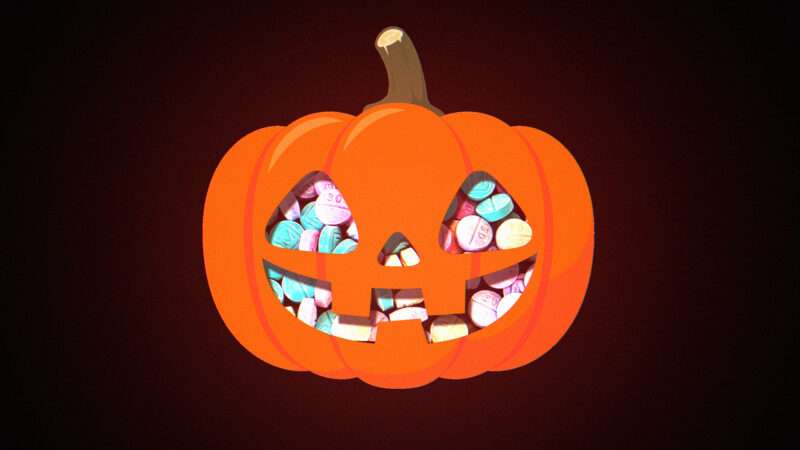
This week, thousands of fentanyl pills were discovered by Transportation Security Administration (TSA) agents at Los Angeles International Airport. What should have been a routine drug bust has ended up fueling continued fears about drug-laced Halloween candy. Why? The pills were smuggled in candy boxes.
Despite a complete lack of evidence that unscrupulous drug dealers are trying to get kids hooked on opioids this Halloween, drug enforcement officials have continually warned parents to be on the lookout for fentanyl pills in their kids' Halloween candy stash. These warnings aren't just baseless—they perpetuate long-debunked myths and spread unnecessary panic among gullible parents.
The TSA agents discovered around 12,000 fentanyl pills in a passenger's carry-on bag. Photos later published on the TSA's Instagram account show the pills were smuggled in boxes and packaging of well-known candy brands, like Whoppers, Skittles, and SweeTarts. Law enforcement officials quickly seized this detail as a reason to warn parents to be on the lookout for fentanyl pills in their children's Halloween candy hauls.
"With Halloween approaching, parents need to make sure they are checking their kids [sic] candy and not allowing them to eat anything until it has been inspected by them," the Los Angeles County Sheriff's Department wrote in a statement released Wednesday. "If you find anything in candy boxes that you believe might be narcotics, do not touch it and immediately notify your local law enforcement agency."
This isn't the first time this fall that law enforcement officials have warned that drug dealers might try to pass out fentanyl pills on Halloween. Over the past several months, officials began seizing brightly colored fentanyl pills, dubbed "rainbow fentanyl." Unfounded speculation that brightly colored pills are meant to attract younger users has morphed into fears that drug dealers will attempt to give the pills away—for free, no less—to children during Halloween trick-or-treating.
"In the past, parents were told to make sure their kids walked in well-lighted areas and to have a safety plan," wrote CBS Bay Area. "Now, checking for rainbow fentanyl is being added to that list."
Even though the pills seized during this week's drug bust at the L.A. airport were all light blue, the fact that they were smuggled in candy boxes has allowed government officials and the media to piggyback on recent "rainbow fentanyl" fearmongering and, yet again, urge parents to worry about deadly drugs in their child's trick-or-treating stash.
However, these claims are baseless nonsense.
"Stories about contaminated treats are best understood as contemporary legends," writes Joel Best, a prominent researcher of "Halloween sadism"—tales of strangers attempting to poison or injure people through Halloween treats. "My data goes back to 1958, and my principal finding is simple: I can't find any evidence that any child has ever been killed or seriously injured by a contaminated treat picked up in the course of trick-or-treating."
According to Best, the latest stories about fentanyl in candy are just as baseless as the tales of marijuana-laced Halloween treats and needle-filled apples before it. "One obvious hole in these concerns is that drugs tend to cost more than candy," writes Best. "The suggestion that a school-age kid would go from accidental user of fentanyl to a paying addict is far-fetched."
As Best notes, "Halloween sadism" myths tend to rely on incredibly illogical thinking—something especially present in law enforcement's response to the fentanyl pills found at the airport. Packing the pills in candy boxes was obviously a shoddy attempt to disguise the illegal drugs from the TSA, not a plan to distribute them to kids as Halloween candy. After all, people who want to get high buy drugs, not candy.
It should also go without saying that no drug dealer is looking to give away his product for free—especially to young children without the means to pay for a budding addiction. "It might not make any sense for someone to give a brightly colored opioid pill…to a small child," writes Best, "but it isn't impossible, is it? Such reasoning is thought to justify ringing the alarm bells."
While rumors of fentanyl pills in Halloween candy are easily dispelled with a moment's thought, it appears that media and law enforcement officials have failed to think this one through.
The post For the Umpteenth Time, No One Wants To Give Your Kid Rainbow Fentanyl appeared first on Reason.com.







